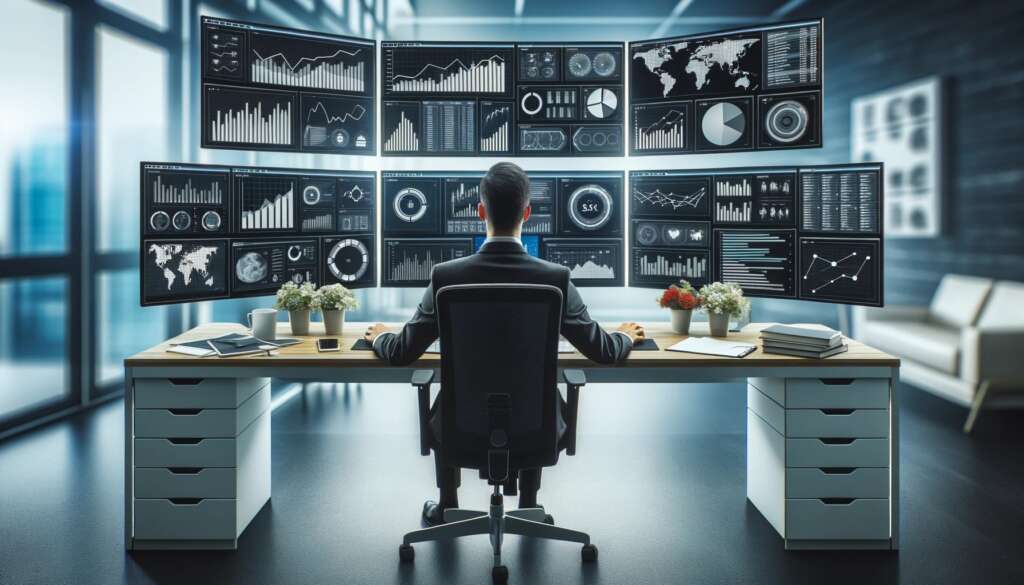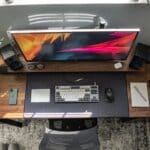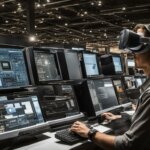Table of Contents
The Transformative Power of Multi-Monitor Setups for Business Professionals
In today’s digitally-driven landscape, Multi-Monitor Setups have become a pivotal element for those aiming to optimize their workspace. The modern professional environment demands more than just a single screen; it requires a comprehensive ecosystem where software, hardware, and human skills synergize to produce the best outcomes. Within this context, having multiple screens serves as a catalyst that enhances various aspects of professional life, from task management to communication.
For business professionals, the workspace is not merely a place to complete tasks; it’s a complex system that must be fine-tuned for productivity and efficiency. Whether you are a freelancer, a corporate executive, or an entrepreneur, this guide will provide you with actionable insights into how a more expansive digital workspace can significantly improve your work experience.
Why Choose This Setup?
In today’s competitive business landscape, having an optimized workspace is more crucial than ever. Traditional single-screen setups may have sufficed in the past, but as the nature of work evolves, so should our tools. This is where multi-screen configurations offer a transformative experience, providing a range of benefits that extend far beyond the surface.
Enhanced Productivity
The most immediate advantage of adopting multiple monitors is the remarkable increase in productivity. Various studies and research reports have indicated that using more than one monitor can elevate productivity levels by as much as 30-40%. This is especially significant for roles that involve data-intensive tasks, software development, or digital design. With extra screen space, you can easily view multiple applications simultaneously, reducing the need to toggle between windows and thus saving valuable time.
Streamlined Multitasking
In the modern work environment, multitasking is not just an asset; it’s a necessity. Traditional setups often limit your ability to manage multiple tasks efficiently. However, dual or triple monitor setups provide the flexibility to have different applications open on separate screens. For instance, you could have your email client open on one screen, a spreadsheet for data analysis on the second, and a presentation software like PowerPoint on the third. This arrangement significantly streamlines your workflow, making multitasking more manageable and less stressful.
Optimal Data Management
Data management is a critical aspect of many professions, particularly those that deal with large datasets, financial modeling, or market research. Navigating through endless tabs and windows is not just time-consuming but also increases the likelihood of errors. Multi-monitor setups offer the convenience of viewing data sets side-by-side, facilitating easier data comparison, cross-referencing, and analysis. This can be particularly beneficial for roles in data science, accounting, and business analysis.
Improved Communication
The rise of remote work and virtual collaboration has made communication tools indispensable. With a multi-screen configuration, you can dedicate one screen solely for video conferencing or team chats. This allows you to actively participate in meetings or discussions while still having immediate access to relevant files, documents, or applications on your other screens. This dual focus can significantly improve your communication efficiency and make virtual collaboration more effective.
By comprehensively understanding these benefits, you are better equipped to make an informed decision that could substantially improve your work efficiency, task management, and overall job satisfaction.
Increased Productivity
The Science Behind the Productivity Boost
One of the most compelling arguments for adopting multi-monitor setups is the significant increase in workplace productivity. According to a study by the University of Utah, users experienced up to a 33% improvement in efficiency when using multiple monitors. This is particularly beneficial for roles that require data analysis, software development, or content creation. The extra screen real estate allows you to have multiple applications and documents open simultaneously, reducing the need to toggle between windows and thus saving valuable time.
Task Segmentation and Focus
Multi-monitor configurations enable you to segment your tasks more effectively. For instance, you could dedicate one screen to research, another to writing, and a third to editing. This form of task segmentation allows you to focus on each aspect of a project without the distraction of constantly switching between applications. The result is a more streamlined workflow that enhances your concentration and task efficiency.
Reduced Errors and Improved Accuracy
When you’re working on complex projects that involve multiple steps or require referencing various documents, the likelihood of making errors increases. Multiple monitors allow you to view all the necessary information at once, making it easier to cross-reference data and thus reducing errors. This is particularly beneficial in data-sensitive roles like accounting, where a small mistake can have significant repercussions.
Time-Saving Shortcuts
The additional screens also allow for time-saving shortcuts. Whether it’s dragging a file from one screen to another or using keyboard shortcuts to navigate between applications, the efficiency gains may seem minor but can add up over time. These shortcuts not only save time but also reduce the physical strain of repetitive tasks, contributing to a healthier work environment.
By understanding the science and practical benefits behind the productivity gains associated with multi-monitor setups, you can make a more informed decision about upgrading your workspace. The advantages are not just theoretical; they have a tangible impact on your work quality and job satisfaction.
Enhanced Multitasking
The Multitasking Advantage
In today’s fast-paced business environment, the ability to multitask effectively is a valuable skill. Multi-monitor setups take multitasking to a new level by providing the workspace flexibility needed to manage multiple tasks and applications simultaneously. According to research by Jon Peddie, multitasking efficiency can improve by as much as 20-30% with the use of multiple monitors.
Role-Specific Benefits
Different professions have unique multitasking requirements. For example, a project manager may need to keep track of timelines, budgets, and team communications all at once. A graphic designer might need to juggle design software, reference images, and client feedback. Multi-monitor configurations allow these professionals to have all the necessary applications and documents open, enhancing their task management capabilities.
Reduced Cognitive Load
Switching between applications and tabs not only wastes time but also increases cognitive load, which can lead to mental fatigue and reduced performance. Having multiple screens allows you to allocate specific tasks to specific monitors, reducing the mental effort required to switch between tasks. This can lead to improved mental well-being and work efficiency.
Customizable Workflows
One of the most appealing aspects of multi-monitor setups is the ability to customize your workflow. Whether you prefer to have your email on one screen, a spreadsheet on another, and a presentation on a third, the choice is yours. This level of customization allows you to create a work environment that aligns with your specific needs and preferences, ultimately enhancing your job satisfaction.
Understanding the various ways in which multi-monitor configurations can improve your multitasking capabilities provides a compelling argument for making the switch. The benefits are not just limited to increased efficiency; they also contribute to a more satisfying and mentally rewarding work experience.
Better Data Management
The Importance of Effective Data Management
In an age where data is often considered the new oil, effective data management is crucial for any business professional. Whether you’re dealing with customer information, financial records, or project timelines, the ability to manage data efficiently can significantly impact your job performance and the success of your projects.
Side-by-Side Data Comparison
One of the most immediate benefits of multi-monitor setups is the ability to view data sets side-by-side. This is particularly useful for roles that require frequent data comparison, such as business analysts, financial advisors, and market researchers. Having the data displayed on multiple screens allows for easier cross-referencing, reducing the likelihood of errors and improving the quality of your work.
Real-Time Monitoring
For roles that require real-time data monitoring, such as stock trading or network management, having multiple monitors is almost a necessity. You can dedicate one screen to real-time graphs, another to historical data, and yet another to your trading or management platform. This setup not only enhances your situational awareness but also allows for quicker decision-making.
Enhanced Data Visualization
Multi-monitor configurations also offer the advantage of enhanced data visualization. For example, you could have a spreadsheet open on one screen and a corresponding data visualization on another. This dual-view approach provides a more comprehensive understanding of the data, aiding in data interpretation and strategic planning.
By leveraging the capabilities of multi-monitor setups, you can significantly improve your data management skills, leading to more accurate and effective work outcomes. The benefits extend beyond mere convenience, offering a more streamlined and efficient approach to handling one of the most critical aspects of modern business: data.
Improved Communication
The Evolving Landscape of Business Communication
In the current era of remote work and global teams, effective communication has become more critical than ever. Whether it’s video conferencing, instant messaging, or collaborative document editing, the tools we use to communicate are integral to our work efficiency and team collaboration. This is especially true in today’s remote work landscape, where communication is not just a skill but a necessity for success. Forbes discusses the importance of effective communication in remote work, emphasizing how dedicated tools and setups, like multi-monitor configurations, can make a significant difference.
Dedicated Communication Screen
One of the standout features of multi-monitor setups is the ability to dedicate an entire screen to communication. This can be particularly beneficial during virtual meetings or webinars, where you may need to reference documents or take notes simultaneously. Having a dedicated screen for communication allows you to be fully engaged in the conversation while still having immediate access to other essential tasks.
Enhanced Collaborative Work
Multi-monitor configurations also facilitate better collaborative work. For instance, you could have a video call on one screen, a shared document on another, and your project management tool on a third. This setup allows for seamless multitasking between communication and task execution, making team collaboration more efficient and effective.
Reduced Disruptions
Constantly switching between communication platforms and work applications can be disruptive and time-consuming. Multi-monitor setups alleviate this issue by allowing you to have your communication tools and work applications open simultaneously, reducing the need to switch back and forth and thus minimizing disruptions to your workflow.
By incorporating multi-monitor setups into your work environment, you can significantly enhance your communication capabilities, leading to better team collaboration, project management, and overall job satisfaction.
Cost-Benefit Analysis
Initial Investment vs. Long-Term Gains
While the advantages of multi-monitor setups are numerous, it’s essential to consider the initial investment required. The cost of additional monitors, mounting hardware, and possibly upgraded graphics cards can add up. However, when weighed against the long-term productivity gains, efficiency improvements, and job satisfaction, the investment often proves to be justified.
Energy Consumption
Another factor to consider is energy consumption. More screens mean more electricity usage, which could lead to higher utility bills. However, modern monitors are increasingly energy-efficient, and the incremental cost is often minimal compared to the productivity benefits.
Workspace Requirements
Space is another consideration. Multi-monitor configurations require a larger desk space, which might not be feasible in all work environments. However, various mounting solutions can optimize workspace utilization, making it easier to accommodate the extra screens.
ROI Calculation
To truly understand the value of implementing a multi-monitor setup, it’s beneficial to calculate the Return on Investment (ROI). This involves quantifying the time saved, errors reduced, and any revenue increases that result from enhanced productivity and then comparing these benefits to the initial and ongoing costs.
By conducting a thorough cost-benefit analysis, you can make an informed decision about whether a multi-monitor setup is the right choice for you. The key is to look beyond the initial investment and consider the long-term advantages that can significantly impact your work quality and career growth.
Choosing the Right Setup
Understanding Your Needs
Before diving into the world of multi-monitor setups, it’s crucial to understand your specific work requirements. Are you a graphic designer who needs high-resolution displays for detailed work? Or perhaps a day trader who requires real-time data across multiple screens? Identifying your needs will guide you in selecting the appropriate hardware.
Monitor Specifications
The specifications of the monitors you choose can significantly impact your work experience. Factors like screen size, resolution, and refresh rate should align with your professional needs. For instance, creative professionals might prioritize color accuracy, while those in data analysis might look for screens with higher resolutions for better clarity.
Compatibility and Connectivity
Ensure that your existing hardware is compatible with the multi-monitor setup you’re considering. Check for the necessary ports like HDMI, DisplayPort, or USB-C and verify that your graphics card can support multiple displays. You might also need additional cables or adapters, so factor these into your budget.
Ergonomics and Mounting Options
Ergonomics play a vital role in your long-term comfort and health. Consider adjustable stands or wall mounts that allow you to position the monitors at eye level, reducing strain on your neck and eyes. Some setups even offer swivel and tilt options for more dynamic adjustments.
Software Considerations
Some professionals might require specialized software that can take full advantage of multi-monitor configurations. Whether it’s trading platforms that allow you to track multiple markets or design software that utilizes the extended workspace, ensure that your software needs are met.
By carefully considering these factors, you can choose a multi-monitor setup that not only meets but enhances your work requirements. The right configuration can be a game-changer, significantly improving your productivity, efficiency, and overall job satisfaction.
Conclusion
In the ever-evolving landscape of business technology, staying ahead of the curve is essential for success. Multi-monitor setups offer a compelling solution for modern professionals seeking to optimize their work environment. From significant productivity gains and enhanced multitasking capabilities to better data management and improved communication, the benefits are both immediate and long-lasting.
However, like any investment, it’s crucial to conduct a thorough cost-benefit analysis to ensure that the setup aligns with your specific work requirements. The initial costs may be a consideration, but the long-term advantages often justify the investment, leading to improved work quality, efficiency, and job satisfaction.
In a world where every second counts, making the switch to a multi-monitor configuration could be the game-changing decision that propels your career to new heights. Whether you’re a freelancer, a corporate executive, or an entrepreneur, the time to optimize your workspace is now.








1 comment
Hello there, I found your website by way of Google whilst searching
for a comparable topic, your website got here up, it seems great.
I have bookmarked it in my google bookmarks.
Hello there, simply turned into aware of your blog thru Google, and located that it is
really informative. I’m going to be careful for
brussels. I will be grateful should you proceed this in future.
Lots of other folks shall be benefited out of your writing.
Cheers!